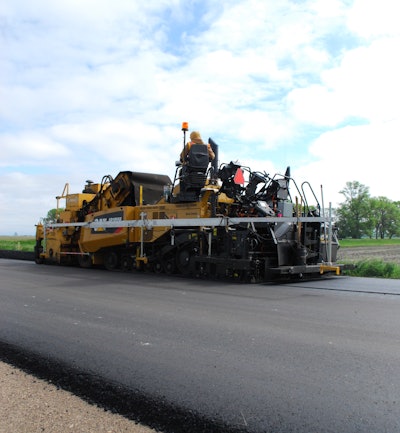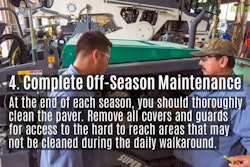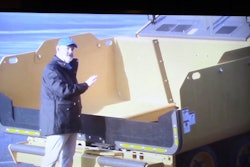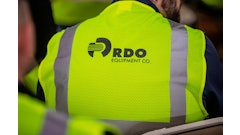
Grade and slope technology is not new to the industry. In fact, it's been available to paving contractors for several years. What is relatively new however is the adoption of the technology to achieve superior paving results. Contractors who aren't using this technology on their pavers are going to start missing out on job opportunities and higher bonus incentives.
In his session at CONEXPO CON-AGG 2020 in Las Vegas, Todd Mansell, product application specialist at Caterpillar, Inc. will help attendees better understand grade and slope (G&S) technology and how it can benefit their business. Here's a preview of what contractors will learn about grade and slope and how it can benefit paving contractors.
What is Grade & Slope Technology?
Automatic G&S provides automated control over the screed tow point cylinders in order to maintain precise mat thickness and percent slope or crossfall during paving operations. These control systems for asphalt pavers provide paving companies with a broad range of benefits including:
- Improved grade and slope accuracy
- Increased productivity
- Assistance with smooth transitions
- Improved mat thickness and yield control
- Decreased costs related to grade and slope re-work
In addition, these systems decrease operator fatigue related to manually controlling grade and slope.
"Mat thickness and slope are often controlled manually by screed operators, however, a properly setup automatic system not only makes the job of the screed operators much easier, but greatly improves accuracy of mat thickness and slope when the sensors and averaging beams (ski’s) are properly setup for the particular job conditions," Mansell says.
Contractors not properly using G&S technology could be missing out on opportunities for higher bonus incentives. Because of the accuracy and consistency, properly configured automatic grade and slope systems can earn contractors maximum incentives, or bonus money for ride quality (smoothness) in States where incentives are offered.
The technology can also assist businesses with their labor issue by reducing the number of skilled workers needed on a paving job.
"It is common practice to have right and left side screed operators on a paving project. When using G&S, often only one screed operator is needed where two may otherwise be required," Mansell says. "On most highway jobs, for example, there is little need for two screed operators when automatic grade and slope systems are properly setup and utilized. Manual control of the screed requires a high level of attention at all times and automatic grade & slope control eliminates some of the “human factor” of fatigue and simply estimating, or “eyeballing” adjustments as opposed to the machine measuring precisely and making adjustments."
And manual adjustments are what lead to quantity overruns which can kill your profits.
"Automatic grade and slope technology can react to certain surface conditions faster and more accurately than a human being can," Mansell says. "It improves quality when it comes to smoothness and dealing with yield and mix quantities. This is especially important when you have to hit a certain amount of yield.
"At a minimum, depending on State specifications, automatic grade & slope can help keep the contractor out of penalty for poor ride and be more accurate on thickness, which directly relates to the quantity, or tons of hot mix placed," Mansell says. "Every tenth of an inch in thickness can add up to several tons and a lot of cost if thickness is not precisely controlled."
Contractors Not Benefiting from Grade & Slope
While most contractors understand the benefits of G&S technology, many are not using it in their daily operations and even fewer are maximizing the benefits of these systems through proper operation. That's where training comes in to place.
"Contractors are not generally resisting using this technology, they have been using it for many years, however, most have never been properly trained on how these systems work," Mansell says. "For this reason, contractors often get frustrated and have more success manually controlling the screed for thickness and slope during paving. Once they gain an understanding of how automatic grade & slope systems work, the contractor can easily configure the setup each day, or for each job, to achieve the results they want."
Sensor position is one important factor in achieving success with G&S systems and many contractors overlook this important step or maybe don't even know how to fix it.
“One of the single biggest things that operators don’t understand about automatic grade and slope control systems is the importance of properly positioning the grade sensors, contact ski and sonic averaging ski,” Mansell says. “Sensor position is critical to the end result and if these sensors are not properly positioned, you are going to have a rough ride rather than a smooth one. If you are matching lanes, the only way to get a perfect joint match is to have the sensors in the right place, otherwise you’ll end up with an uneven lane match.”
Poor ride from improper sensor position is what often leads to the automatic grade and slope system being tossed out behind the shop because the crew blames the system, he adds. In reality, it is just a lack of training on proper setup.
"When someone doesn’t understand how something works or they have had a bad experience, they are not going to use it. They get frustrated and don’t use it any more," Mansell says. "Training changes that."
To learn how to feel comfortable setting up and using automatic grade and slope systems over a wide range of applications to achieve exceptional results, attend the “Taking the Voodoo out of Automatic Grade & Slope Control” education session at CONEXPO-CON/AGG 2020 in Las Vegas. This session is scheduled for Thursday, March 12, from 3:00 p.m. to 4:00 p.m. More information can be found at www.conexpoconagg.com.
"The purpose of this training session is to show how these systems works so the contractor can confidently set the system up to achieve the particular job results they are looking to achieve," Mansell says. "With training and experience, contractors understand how it works and love it because it makes their job so much easier. They are not physically and mentally adjusting the screed and watching what’s coming up which completely changes the complexity of their day."















![Lee Boy Facility 2025 17 Use[16]](https://img.forconstructionpros.com/mindful/acbm/workspaces/default/uploads/2025/09/leeboy-facility-2025-17-use16.AbONDzEzbV.jpg?ar=16%3A9&auto=format%2Ccompress&fit=crop&h=135&q=70&w=240)




